SMX Advanced recap: Audience targeting in a privacy-centric world
Contributor Keri Morgret recaps a session covering new developments in audience targeting and how tracking changes will affect the way you use audience targeting and remarketing.

Here is a recap of SMX Advanced session Audience Targeting In A Privacy-Centric World. The speakers shared new developments in audience targeting and how tracking changes will affect the way you use audience targeting and remarketing.
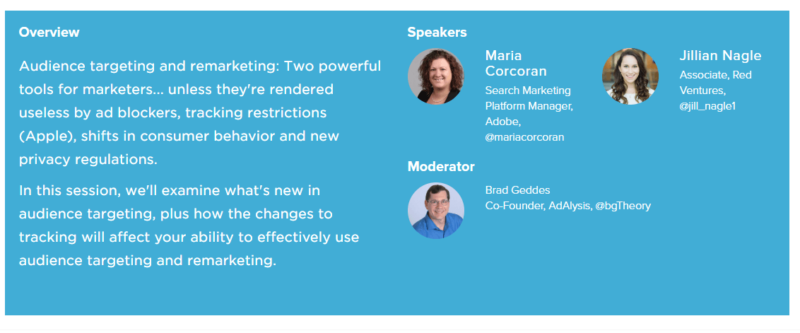
Jillian Nagle, Red Ventures
Jill started the session by saying,
If we evaluate audiences the same way we evaluate keywords, our strategy will be more scalable and impactful.
Several years ago, most presentations were about keywords and ad groups, now the presentations are taking the tactics associated with ad groups and keywords and applying them to audiences.
Don’t get caught up in thinking each audience needs to have a unique treatment. This can be a detriment to scale, impact, and simplicity. It can be hard to iterate and make changes, as the audiences can be too small and there are too many changes to make. Instead, find the most meaningful way to segment.
Jill’s team found three groups that all needed a similar purchase path and grouped them together in one audience for testing. Her advice is to look for audiences that perform similarly and roll them into a single audience.
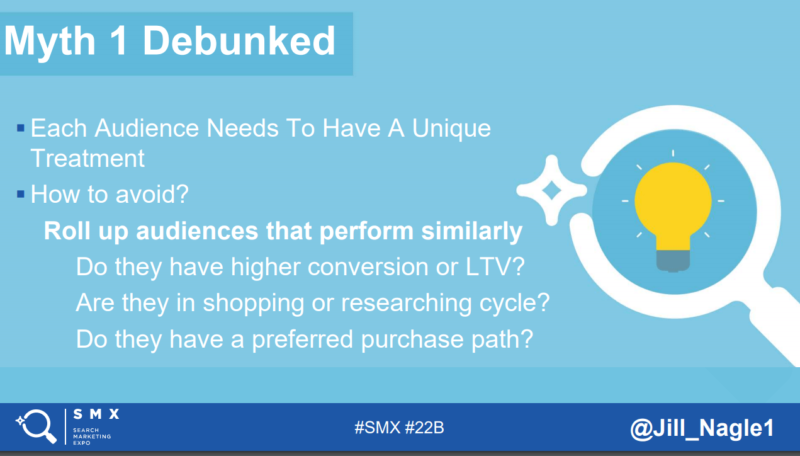
You don’t always want to change the bid or ad copy based on audiences, but you can use audiences further down the funnel. For a financial services site, changing the credit cards that were featured on the landing page was the most effective use of audiences, rather than changing the ad copy.
Go beyond the ad, audiences are an entire team initiative. Look at the funnel, and find where the user behavior truly changes. The behavior change is where you need to personalize for your audiences.
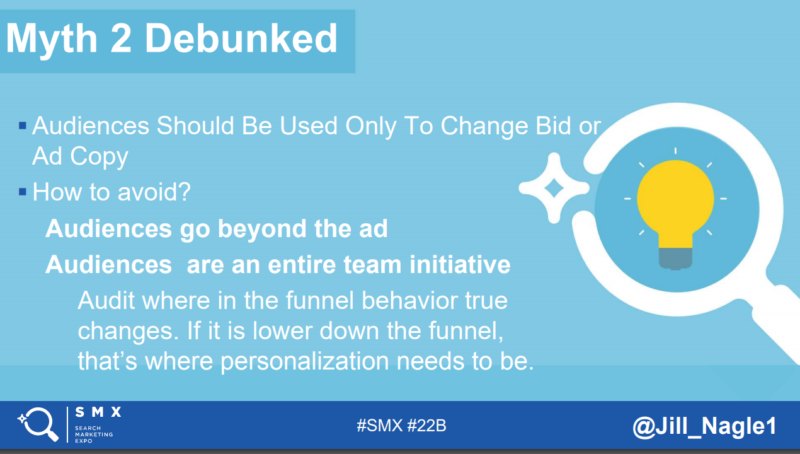
Don’t forget to look for your low-value audiences and exclude them. This will help you reduce your spend and make the most of your budget. You don’t need to invest in selling commercial air conditioning units to 18-year-olds.
Being specific with audiences also let you do broader targeting. You can target business executives with landing page copy about business banking, even if they’ve only searched on the keyword banking.
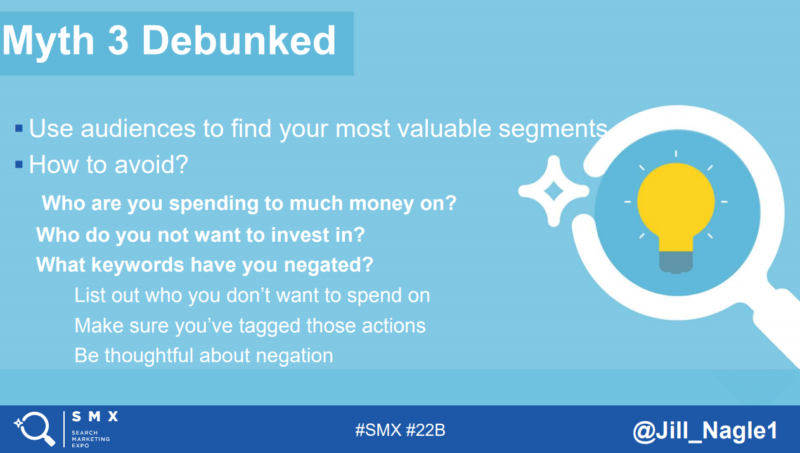
Presentation deck: Debunking Audience Myths
Maria Corcoran, Adobe
Maria started out by saying if you’re eager to define an audience and get started with your advertising, you first need to need to put some thought into your audience creation.
Create your audiences with a purpose. Your key performance indicators (KPIs) and goals need to be aligned to your audience – map a conversion event to your audience purpose.
Once you’ve set your audience, don’t walk away and forget it. Just because it’s doing well now doesn’t mean you can ignore the audience and expect it to continue doing well. Look at the audience performance, make sure the audience definition matches your customer, test your ads, expand your cookie pools, test retargeting, and so on.
Using dynamic search ads (DSA) and remarketing lists for search ads (RLSA) can be powerful for the top of the funnel.
Before turning on your ads and spending money, listen to your audience:
- What devices do they use?
- When do they visit your site?
- Are they mainly new visitors, or return visitors?

Now we’re on to General Data Protection Regulation (GDPR) and privacy.
If ‘audiences’ feel like the new version of keywords, GDPR really feels like the new version of ‘not provided’ in the current industry discussions.
It’s not that they are equivalent by any means, but it’s the same feeling of there’s something new and big out here that is affecting us, it’s removing some of the visibility we have into our data and forcing us to look at what we’re doing in a new way.
When GDPR rolled out in the EU on May 25, over sixty percent of the users were not consenting to the tracking notice Adobe issued in their conservative rollout. Their conversion volume was not affected. People are still on the Adobe site, but they have a yellow cookie banner follow them around the whole site.
Maria advises caution when analyzing success via bidding platforms. A visit to Adobe’s second page showed in analytics, but the first-page visit wasn’t tracked. They had a huge spike in “bookmark” and “direct to the site” visits. They’re working on setting a cookie that lasts 30 seconds on the home page.
Here are some of the concerns Maria’s team has about the GDPR impact, and what they’ve experienced so far.
- Will AdWords Quality score be impacted by the consent Banner Ads?
- Google’s given conflicting information about this.
- How will losing over 60% of the audience lists impact campaign performance?
- How do you get a higher “consent” rate?
- The intrusive banner does have the best consent rate so far, but it is obnoxious. They are testing and seeing what works.
- Will consent rate vary by country?
- So far, it has varied by country. They’re seeing if they can target countries by consent rates. It’s great to have historical data to know how things were converting before.
- When will this go global?
Microsoft has announced they will roll this out globally. Several other sites have rolled it out as well, including Yahoo and CNN.
Similar Audiences is another great tool. Adobe got 97% higher cost per action (CPAs) in the region, the CPA is higher on all devices, and the global CPA is 2x for similar audiences.
Another tip is to keep up on the upcoming features in the ad platforms and ask to be included in beta testing. Google has an in-market audience coming up that might be helpful.
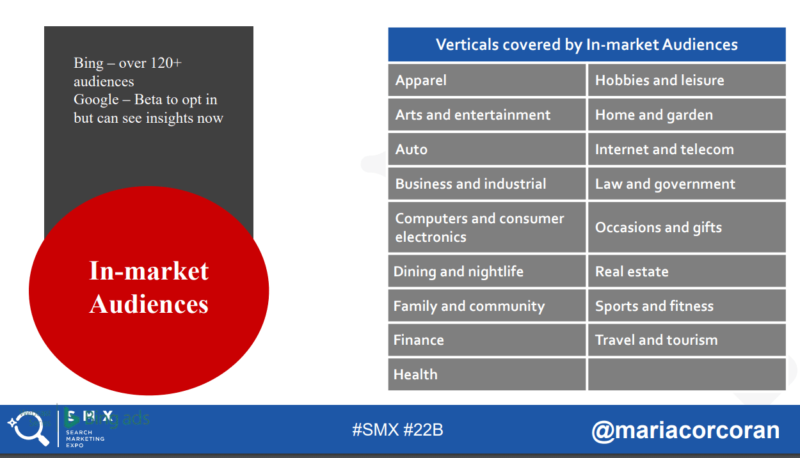
Don’t forget your negatives! Just like you have negative keyword lists to improve your performance, you want to do the same thing with audiences.
Search engine advertising is a way to make up for the data you can’t get because of GDPR. LinkedIn has targeting based on intent, profile, location, and device. Microsoft has native ad placements. Bing lets you target audiences in search and audiences in the Microsoft Audience Network.
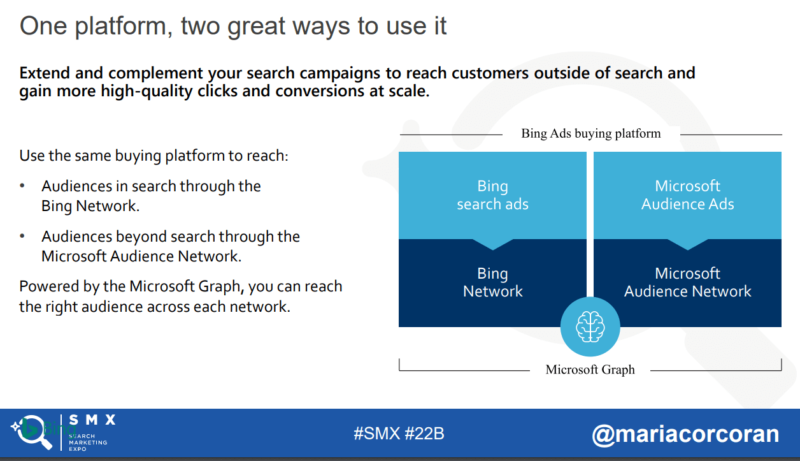
Maria said GDPR and audience targeting will be on marketing conference agendas for many seasons to come.
Key takeaways from Maria:
- Experiment with all Audience types
- Similar and in-market audiences are the future
- GDPR is affecting 70% of EU data
- Map Audience goals and program
Presentation deck: Audiences, 5+ Years Later and GDPR
Want to learn more? Join us in October our SMX East conference in New York City, where top industry experts will share their tips, tactics and strategies around SEO and SEM topics.
Contributing authors are invited to create content for MarTech and are chosen for their expertise and contribution to the martech community. Our contributors work under the oversight of the editorial staff and contributions are checked for quality and relevance to our readers. MarTech is owned by Semrush. Contributor was not asked to make any direct or indirect mentions of Semrush. The opinions they express are their own.
Related stories